Hommage au regretté Père Jean Baptiste Pierre Halaby (1923-1977).
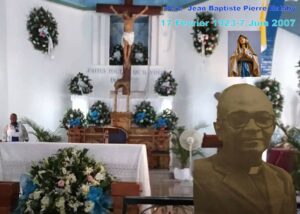
Hommage au regretté Père Jean Baptiste Pierre Halaby (1923-1977).
https://pawaspititmanmanroze-cdb.com/hommage-au-regrette-pere-jean-baptiste-pierre-halaby-1923-2007/
Le 340e anniversaire de la Paroisse Notre-Dame du Rosaire de la Croix-des-Bouquets touche à sa fin au terme du mois de décembre 2023. C’est une année encore très difficile pour Haïti, particulièrement pour la Croix-des-Bouquets. Cette paroisse a une grande histoire, elle est l’une des plus anciennes de la République d’Haïti et l’une des plus grandes paroisses de l’archidiocèse de Port-au-Prince. Elle fut fondée au temps de la colonie. L’église paroissiale Notre-Dame du Rosaire de la Croix-des-Bouquets est et restera toujours un grand patrimoine pour la communauté crucienne d’Haïti et de la diaspora.
Pour clôturer le 340e anniversaire de la Paroisse Notre-Dame du Rosaire, j’ai jugé bon d’écrire ce texte sur le regretté Père Jean Baptiste Pierre Halaby, le 2e prêtre de l’église catholique d’Haïti originaire de la Croix-des-Bouquets. La paroisse Notre-Dame du Rosaire a déjà donné 17 prêtres. Le Père Halaby, ce grand bâtisseur de foi, doublé de rassembleur, est une grande lumière pour l’église catholique d’Haïti, pour les prêtres originaires de la Croix-des-Bouquets et pour la grande communauté crucienne pour son humilité, pour sa grande solidarité ecclésiale, sa grande proximité avec les pauvres et ses grandes qualités de relations humaines.
Le Père Jean Baptiste Pierre Halaby était né le 17 février 1923 à la Croix-des-Bouquets et était issu d’une famille de 4 enfants . Il était le fils de Monsieur Jean Baptiste Pierre Halaby et le 4e enfant de Madame Irma Mirville. Le Jeune Halaby dès son enfance était très spirituel et il était aussi un ancien enfant de chœur de la Paroisse Notre Dame du Rosaire de la Croix-Des-Bouquets. La famille Mirville est parmi les anciennes familles de la Croix-des-Bouquets. Le papa du Père Halaby était originaire de la Syrie et sa mère était l’une des belles femmes de la communauté crucienne de son temps. Le jeune Jean Baptiste Pierre Halaby avait fait toutes ses études secondaires à Port-au-Prince au Petit Séminaire Collège Saint Martial, considéré comme l’une des plus prestigieuses écoles d’Haïti à l’époque.
C’est au Petit Séminaire Collège Saint Martial que le jeune Halaby avait entendu la voix du Seigneur qui lui demandait de venir travailler dans sa vigne. Il accepta ainsi de donner à Dieu toute son existence dans la vie sacerdotale. On m’avait toujours fait savoir que ce sont les jeunes issus de l’élite d’Haïti ou des jeunes qui avaient la bénédiction des curés Bretons en Haïti qui avaient la chance d’étudier au Petit Séminaire Collège Saint Martial à l’époque du jeune Halaby. Ce dernier, après ses études secondaires, fut accepté à l’École Apostolique pour continuer son cheminement avec Dieu afin de recevoir une solide formation et mieux discerner son appel ou sa vocation. La vie d’un appelé dans la moisson du Seigneur est toujours un moment spécial, un temps de profondes réflexions, de profonds discernements et de relation intime avec Dieu. Le Seigneur et Manman Wozè ont bien accompagné le jeune Halaby dans son itinéraire spirituel et intellectuel depuis ses études primaires, secondaires, à l’École Apostolique et au cours de ses 28 années de vie sacerdotale.
Comment était la vie des étudiants haïtiens de l’École Apostolique d’Haïti à l’époque du jeune Halaby? En ce temps-là on n’avait pas encore le Grand Séminaire Catholique en Haïti. L’École Apostolique d’Haïti se trouvait sur la cour de l’Archevêché de Port-au-Prince. Les candidats à la prêtrise étaient sous haute surveillance et ont surmonté beaucoup d’obstacles avant d’arriver à leur ordination comme prêtre au sein de l’église catholique. Vous pouvez comprendre facilement les problèmes et les défis des candidats au sacerdoce ministériel qui avaient étudié à l’École Apostolique de Port-au-Prince. Toutes les ordinations sacerdotales des prêtres haïtiens de ce temps et même avant se faisaient dans l’archidiocèse de Port-au-Prince et nos évêques étaient des étrangers ou des Français.
À cet effet, il est bon de souligner que L’encyclique Princeps Pastorum du Pape Jean XXIII (30 novembre 1959) nous a toujours rappelé l’importance d’un clergé local . Cela prend nécessairement l’établissement d’une hiérarchie locale composée de prêtres et d’évêques de ce pays. L’encyclique Maximum Illud ou la lettre apostolique du Pape Benoît XV (30 novembre 1919) a beaucoup insisté sur le fait que le prêtre autochtone ou local par son origine, son caractère, ses sentiments, ses inclinations et ses intérêts est lié plus intimement au peuple dont il est issu, ce qui lui donne une facilité sans pareille pour introduire la foi chrétienne dans l’esprit de son peuple. On ne doit pas oublier la déclaration du Pape Pie XI (6 février 1922-10 février 1939) qui nous fit savoir que le seul moyen de résoudre vraiment le problème du besoin des prêtres en pays de mission, c’était d’en former sur place.
Il nous a fallu attendre jusqu’au 28 octobre 1966, après plus d’un siècle de la signature du Concordat entre l’État Haïtien et le Vatican, pour voir les fils d’Haïti assumer la direction spirituelle des diocèses d’Haïti. Personne ne peut oublier le fameux chant du grand samba Joseph Augustin (Papy Djo) pour la consécration épiscopale du 28 octobre 1966 des premiers évêques Haïtiens : « Evèk Kreyòl nan Pep Kreyòl, Bondye paret tout an Kreyòl… ». Papy Djo était le frère de Monseigneur Rémy Jérôme Augustin de la Compagnie de Marie (en latin : Societas Mariæ Montfortana), les Montfortains. Il fut le premier évêque Haïtien et premier évêque haïtien du diocèse de Port-de-Paix (30 septembre 1910-29 mars 1983)
Par ailleurs, le jeune Halaby était connu comme un grand sportif. Il jouait très bien au Football et grâce à ses talents il pouvait même être parmi les joueurs de la sélection nationale haïtienne. Sa grande passion pour le football le portait parfois à voyager pour aller supporter la sélection nationale dans ses tournois à l’étranger.
Vous pouvez imaginer la joie des parents du père Halaby et la communauté crucienne de foi catholique en assistant à son ordination sacerdotale le 11 juillet 1949. Il fut ordonné à la cathédrale de Port-au-Prince par Monseigneur Joseph Le Gouaze, archevêque de Port-au-Prince. Il était vicaire ou assistait le Père Farnèse Louis Charles de septembre 1949 au mois de mai 1950. Il a exercé successivement son ministère à la Cathédrale de Port-au Prince, directeur de l’École Apostolique, aumônier général de la jeunesse étudiante féminine, administrateur de la paroisse du Christ Roi, Curé de la Paroisse Ste Rose de Lima où il a transformé le chœur de l’église en y introduisant l’autel face au peuple à la grande stupéfaction et à l’admiration de tout le monde, et enfin Curé de la Paroisse St Joseph en l’année 1967 où il a passé les 10 dernières années de sa vie.
Selon mes recherches Le regretté Père Halaby était un grand prédicateur et il prenait toujours le soin de bien préparer ses homélies et ses célébrations liturgiques. Il a introduit la messe en Créole dans la paroisse de Saint Joseph ainsi que l’utilisation du tambour, au cours d’une grande et belle célébration eucharistique ou le Reverend Père Joseph Augustin (Papy Djo) de la troupe Tamboula , connu comme l’un des grands Sambas Haitiens et qui a joué un grand rôle à la réussite de cette célébration eucharistique . Le Père Halaby , ce grand bâtisseur de foi a renforcé la dévotion à St Joseph lorsqu’il a pris la décision de célébrer une messe chaque mercredi à 11 :00hres am à la paroisse Saint Joseph ou les pèlerins de toutes les couches sociales de la société Haitienne venaient de partout (y compris les paroissiens de la paroisse Notre Dame du Rosaire de la Croix-Des-Bouquets) prier à cette cérémonie religieuse ou pour implorer l’aide de Saint Joseph pour une ou des causes difficiles .
L’agrandissement de l’église de la Paroisse St Joseph figure parmi les grandes réalisations du Père Halaby. Selon le prêtre-avocat Jomanas Eustache, le Père Jean Baptiste Pierre Halaby fut le premier à introduire l’orgue életronique au sein de l’église St Joseph à l’occasion du centenaire de la paroisse en l’année 1973 et il aurait été le premier prêtre catholique à organiser une messe de minuit le 31 décembre dans l’archidiocèse de Port-au-Prince à la paroisse de Saint Joseph. Il a restauré le presbytère de la paroisse St Joseph. Il a fondé le Centre Medico Social dirigé par les Filles de la Sagesse. On ne peut pas oublier que c’est sous son leadership qu’on arrivera à jumeler la paroisse St Joseph de l’archidiocèse de Port-au-Prince et celle de Ste Claire de Sommerville de l’archidiocèse Montréal..
Selon les informations recueillies, le Père Halaby était elevé au rang de chanoine. Il était parmi les collaborateurs importants de l’archevêque Le Gouaze dans la conduite des affaires religieuses de l’archidiocèse de Port-au-Prince. Il était un prêtre très cultivé, un bon écrivain. Il avait écrit plusieurs articles au Journal Catholique la Phalange. Selon le Père Danis Ridoré, ancien curé de l’église de Jacmel devenu la cathédrale de Jacmel et ancien vicaire de la paroisse St Joseph à Port-au-Prince pendant 2 ans, le Père Halaby était très bon ou toujours correct avec ses paroissiens. Il traitait toujours bien ses collaborateurs. Il avait une grande proximité avec les pauvres d’Haïti. Il aimait les pauvres qui mendiaient à la barrière de l’église et les aidait de son mieux. Le Prêtre-avocat Jomanas nous a raconté cette anecdote sur le Père Halaby: « Les anciens Port-au-Princiens de sa génération et de la précédente se souviennent encore sans doute des chalands, sorte de camionnette destinée à transporter les va-nu-pieds, les crasseux ou les déguenillés interceptés à travers la ville. C’était au cours de la semaine d’avant la célébration de la St Joseph, l’administration communale de Port-au-Prince avait l’habitude, conformément aux Statuts diocésains dérivés du Concordat, de faire peindre les façades principales et latérales de l’église paroissiale ainsi que le nettoyage de tout le périmètre de l’édifice. Un beau matin, les hommes d’un chaland débarquent soudainement et embarquent tous les pauvres qui étaient à leur portée. Informé de cette “razzia”, le Père Halaby arriva immédiatement sur place et monta prendre place dans la camionnette au milieu des malheureux. Prié de descendre, il refusa catégoriquement arguant qu’il ne le fera qu’à condition de faire descendre avant lui tous les autres. Devant une telle détermination, le commandant a satisfait à la demande du prélat en ordonnant à ses hommes de faire évacuer le véhicule. Et dire qu’on était sous la dictature ! ».
En outre, le Père Halaby aimait rire, il avait de très bons amis dans le clergé haïtien. Le Prêtre-avocat Jomanas Eustache, ancien enfant de chœur du Père Halaby à la paroisse St Joseph, m’a envoyé une liste d’évêques et de prêtres qui allaient visiter le Père Halaby à la paroisse St Joseph: Mgr Rémy Augustin, premier évêque haïtien et ancien Évêque de Port-de-Paix ; Mgr François Wolf Ligondé, premier Archevêque haïtien de Port-au-Prince ; Mgr Jean-Baptiste Décoste, ancien Évêque auxiliaire de Port-au-Prince, promu Évêque fondateur du diocèse de Hinche en avril 1972 ; Mgr Jean-Jacques Claudius Angénor, premier Évêque haïtien du diocèse des Cayes ; Mgr Alexandre ancien régent de l’Archidiocèse de Port-au-Prince et curé de Ste Bernadette à Martissant ; Mgr Albert Dorélien, Vicaire général et curé de Carrefour ; Mgr Jean Noël, curé de la cathédrale de Port-au- Prince ; Mgr Emmanuel Kébreau, ancien prélat d’honneur de Sa Sainteté et curé de Sainte Anne ou encore les Pères Delva, aumônier de l’hôpital de l’Université d’État d’Haïti, plus connu à l’époque sous le nom d’hôpital général ; Père Eustache St Hubert, ancien curé de Jacmel ; le Chanoine Roger Cassagnol, curé de Petit Goâve ; les Pères Marion, curé de la Croix-des-Bouquets, Bouillaguet, curé de Bodari, Joseph Atis, curé de St Martin (St Yves) à Delmas, Dominique Henry, ancien curé des Abricots, Burnet François, curé de Bodin, Pierre Laforêt de St Martial, P. Marc Hilaire de Port Margot, P. Eugène Marie Thalès, qui était encore moine (probablement le premier moine haïtien, à notre connaissance, en tous cas), il allait souvent visiter le Père Jean Noël, à la Cathedrale, Le Père Kébreau à la paroisse Sainte Anne, Le père Albert Dorélien à Carrefour, Le Père Saint Hubert et le Père Delva.
Monseigneur Madelon Eustache, ancien Curé de la paroisse Notre-Dame du Rosaire de la Croix-des-Bouquets, Curé de la Paroisse Notre-Dame du Perpétuel Secours à Laserre et l’un des grands sambas de l’Église Catholique d’Haïti, se souvient du Père Halaby comme un artisan de paix, d’unité et de communion au sein du clergé haïtien. Son presbytère était un lieu de ralliement, un centre d’attraction pour ses confrères. Le Père Halaby était un prêtre exemplaire, très sensible, très fraternel, bon blagueur et riait parfois jusqu’aux larmes lorsqu’il était avec ses amis préférés. Il s’intéressait beaucoup à la politique haïtienne, il écoutait régulièrement les nouvelles d’Haïti. Avec ses amis il ne cachait jamais son opinion et sa position sur les sujets d’actualité d’Haïti.
J’avais la chance d’avoir au téléphone le Père William Smarth, l’une des sommités du clergé haïtien, docteur en Droit Canon, qui a déjà plus de 60 ans de vie sacerdotale et auteur d’un ouvrage intitulé ‘‘Histoire de l’église d’Haïti de 1492 à 2003’’. Il m’a fait savoir que le Père Halaby était un prêtre très cordial, un bon nationaliste, il était l’ami de tout le monde et avait tout fait pour être un bon prêtre haïtien de son temps. Le Père Smarth a aussi mentionné les problèmes et les défis des candidats à la prêtrise en Haïti au temps de Jean Baptiste Pierre Halaby. Je vous exhorte à lire l’ouvrage du Père Smarth (Histoire de l’église Catholique d’Haiti de 1492 à 2003 si vous voulez avoir une bonne idée de l’église d’Haiti.
Notre vie sur terre est toujours un court pèlerinage. Le Père Jean Baptiste Pierre Halaby est mort le 7 juin 1977 aux États-Unis à l’âge de 54 ans après une maladie courageusement supportée. Ses funérailles ont été chantées à la paroisse St Joseph a Port-au-Prince et ses restes inhumés à l’église St Joseph . Pour Beaucoup comme Le Père-Avocat Jomanas et le Père Danis Ridore Le regretté Père Halaby est parti trop jeune. Son Départ a provoqué un grand deuil dans tout Port-Au-Prince et à la Croix-Des-Bouquets. Nous continuons à travailler pour avoir une émission en l’honneur du regrette Père Halaby, ce fils de la Croix-des-Bouquets, cet artisan de paix et d’unité au sein du clergé haïtien. Je remercie vivement Mme Fulvie Bellevue, cette crucienne qui vit à Ottawa qui m’a encouragé à écrire un texte sur le regretté Père Halaby, Mr. Jean Philippe Vixamar, économiste de formation et ancien président de la Banque Nationale de Crédit en Haïti qui m’a envoyé les premières informations sur le Père Halaby ; Le Prêtre-avocat Jomanas Eustache, Mgr. Eustache Saint Hubert , le Père Danis Ridoré, Le Père William Smarth PhD, le Père Godefroy Midy SJ, Monseigneur Madelon Eustache et son Excellence Monseigneur Joseph Gontrand Décoste qui ont apporté leur précieuse contribution à la réalisation de ce texte sur le regretté Père Jean Baptiste Pierre Halaby. Puisse son âme se reposer en paix !
Frère Buteau (frère Tob)
Omaj Pou defen Pè Jean Baptiste Pierre Halaby (1923-1977).
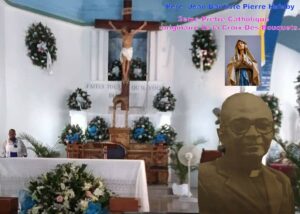
Omaj Pou defen Pè Jean Baptiste Pierre Halaby (1923-1977).
340èm anivèsè Pawas Not Dam Di Wozè ap fini nan fen Desanm 2023. Se toujou yon ane trè difisil pou Ayiti, sitou pou Kwadèboukè. Pawas sa a gen yon gwo istwa, li se youn nan pi ansyen Pawas nan Repiblik d’Ayiti ak youn nan pi gwo pawas nan Achidyosèz Pòtoprens. Li te fonde pandan tan La koloni. Legliz Not Dam Di Wozè nan Kwadèboukè se e l’ap toujou rete yon gwo eritaj pou kominote “Crucian” yo an Ayiti ak nan dyaspora a.
Pou ajoute yon bouke flè lan 340èm anivèsè Pawas Not Dam Di Wozè nan kwadèboukè, mwen te wè l bon pou’m ekri tèks sa-a sou defen Pè Jean Baptiste Pierre Halaby, 2yèm prèt Legliz Katolik Ayiti ki Pitit Pawas Not Dam Di Wozè nan Kwadèboukè. Pawas Manman Wozè nan Kwadèboukè deja bay 17 prèt. Pè Halaby, gran “batisè” lafwa sa a, Gwo Inifikatè sa a, se yon gwo limyè pou Legliz Katolik Ayiti, pou pè ki pitit Kwadèboukè ak pou gwo kominote moun ki soti Kwadèboukè, pou imilite li, pou gwo solidarite eklezial li, gwo pwoksimite li ak pòv yo kòm yon prèt ki te fè ve obeyisans, chastete ak povrete e tou pou bon jan li ak bon kalite relasyon ak moun li gen nan li .
Pè Jean Baptiste Pierre Halaby te fèt 17 fevriye 1923 nan Kwadèboukè e li te soti nan yon fanmi 4 pitit sou bò manman l. Li te pitit mesye Jean Baptiste Pierre Halaby, e se 4yèm pitit Madan Irma Mirville. Jenn Halaby depi nan anfans li te trè espirityèl e li te tou yon ansyen anfannkè pawas Not Dam Di Wozè nan Kwadèboukè. Fanmi Mirville se nan mitan ansyen fanmi Kwadèboukè Fanmi Mirville se youn nan ansyen fanmi Kwadèboukè. Papa Pè Halaby a te soti nan peyi Siri e manman l ‘se te youn nan bèl fanm nan kominote Kwadèboukè nan tan li.
Jean Baptiste Pierre Halaby, tou jenn, te fè tout etid segondè li nan Pòtoprens nan Petit Seminè Kolèj “ Saint Martial ”, ki te konsidere kòm youn nan lekòl ki pi prestijye ann Ayiti nan epòk la.
Se nan Peti Seminè Kolèj “ Saint Martial ”, jenn Halaby tande vwa Granmèt la mande l pou l vin travay nan jaden rezen li a. Konsa, li te dakò bay Bondye tout egzistans li tout lavi li kòm prèt. Yo te toujou di mwen se jèn ki soti nan elit peyi Dayiti oswa jèn ki te gen benediksyon prèt breton an Ayiti ki te gen chans etidye nan Petit Seminè Kolèj “ Saint Martial ” nan tan jèn Halaby. Apre etid segondè li, yo te aksepte’l nan Lekòl Apostolik la pou l kontinye cheminman li ak Bondye yon fason pou li resevwa yon fòmasyon solid, e pou li rive pi byen konprann apèl li te resevwa, kidonk vokasyon li.
Lavi yon moun ke Segnè-a rele nan rekòt li-a toujou mande yon tan espesyal, yon tan refleksyon pwofon, yon disènman pwofon ak yon bon relasyon entim ak Bondye ak Manman Mari. Manman Wozè te akonpaye jèn Halaby nan cheminman espirityèl ak entelektyèl li depi nan etid primè ak segondè, rive nan Lekòl Apostolik la ak pandan 28 ane lavi li kòm prèt…
Kijan lavi etidyan ayisyen te ye nan Lekòl Apostolik Ayiti nan tan jèn Halaby? Nan epòk sa a nou pa t poko gen Gran Seminè Katolik an Ayiti. Lekòl Apostolik Ayiti te chita nan lakou Acheveche Pòtoprens. Sila yo ki te Kandida pou rive lan lavi Pè-a, yo te anba sipèvizyon sere e yo te dwe simonte anpil obstak anvan yo te rive nan òdinasyon yo kòm prèt nan Legliz Katolik la. Ou ka byen konprann pwoblèm ak defi kandida pou sasèdòs ministeryèl yo ki te etidye nan Lekòl Apostolik Pòtoprens te jwenn. Tout òdinasyon prèt ayisyen nan epòk sa a e menm anvan yo te fèt nan achidyosèz Pòtoprens, epi evèk nou yo sete etranje oswa franse.
Pou sa, li bon pou nou mete aksan sou ansiklik “Princeps Pastorum”, Pap Jan XXIII (30 novanm 1959) ki toujou raple nou enpòtans klèje endijèn yo (lokal yo) nan peyi misyon yo. Dokiman sa a te souliye nesesite ki genyen pou tabli yon yerachi lokal ki konpoze de prèt ak evèk peyi misyon yo. Selon Ansiklik “Maximum Illud” la oswa lèt apostolik Pap Benedict 15 (30 Novanm 1929), moun ki soti nan kilti pa li, genyen yon fasilite san parèy nan entwodwi lafwa kretyen an nan lespri pèp li a. Nou pa dwe bliye deklarasyon Pap Pius 11 (6Fevrye 1922-10 Fevrye 1939). Pou vrèman rezoud pwoblèm nan, nou bezwen prèt nan peyi misyon yo, prensip la, se te fòme yo sou plas. Nou te oblije tann jiska 28 oktòb 1966, apre plis pase yon syèk depi Konkòda Leta ayisyen an ak Vatikan te siyen (1860), pou nou wè pitit gason d’Ayiti yo pran direksyon espirityèl dyosèz Ayiti yo. Pèsonn pa ka bliye chante gwo samba Joseph Augustin (Papy Djo) pou konsekrasyon episkopal premye evèk ayisyen yo nan dat 28 oktòb 1966: “Evèk Kreyòl nan yon legliz an Kreyòl, pou yon Pèp an Kreyòl…”. Papy Djo te frè Monseyè Rémy Jérôme Augustin nan Konpayi Mari a (nan Laten: Societas Mariaæ Montfortana), Montfortain yo. Silaa se te premye evèk ayisyen ak premye evèk ayisyen nan dyosèz Port-de-Paix (30 septanm 1910 – 29 mas 1983)
Anplis de sa, jèn Halaby te fè remake li kòm yon gwo spòtif. Li te jwe foutbol trè byen e gras ak talan li, li te ka menm pami jwè seleksyon Nasyonal ayisyen an. Gwo pasyon li pou foutbòl pafwa mennen l ‘nan vwayaje al sipòte seleksyon nasyonal la nan tounwa li yo a letranje.
Ou ka imajine lajwa paran Pè Halaby ak kominote Kwadèboukè nan lafwa katolik la, lè yo te asiste òdinasyon li kòm prèt nan dat 11 jiyè 1949. Monseyè Joseph Le Gouaze, achevèk Pòtoprens, te òdone l nan katedral Pòtoprens. Li te vikè oswa li te asiste Pè Farnese Louis Charles depi septanm 1949 pou rive me 1950. Li te egzèse ministè l nan katedral Pòtoprens, direktè lekòl apostolik la, omonye jeneral jèn etidyan yo, administratè pawas Kris Wa, Pastè oswa kire Pawas Ste Rose de Lima (Léogane) kote li te transfòme kè legliz la lè li te entwodui lotèl la anfas pèp la. Se te gwo sezisman ak admirasyon pou tout moun, epi finalman li te Pastè oswa kire Pawas Sen Jozèf nan ane 1967 kote li te pase 10 dènye ane nan lavi li.
Dapre rechèch mwen an, defen Pè Halaby te yon gwo predikatè e li te toujou pran swen pou prepare omeli yo ak selebrasyon litijik li yo byen. Li te kòmanse mès an kreyòl nan pawas Sen Jozèf ak itilizasyon tanbou a, pandan yon gwo e bèl selebrasyon ekaristik kote Reveran Pè Joseph Augustin (Papy Djo) nan twoup Tamboula a, ke yo rekonèt tankou youn nan gwo Samba ayisyen yo. e ki te jwe yon gwo wòl nan siksè selebrasyon ekaristik sa a. Pè Halaby, gran batisè lafwa sa a, te ranfòse devosyon pou Sen Jozèf lè li te pran desizyon pou l selebre yon mès chak Mèkredi a 11è nan maten nan pawas Sen Jozèf pou pèlren ki soti nan tout kouch sosyal peyi Ayiti a. Ayisyen soti toupatou (ladan yo pawasyen pawas Not Dam Di wozè ki soti Kwadèboukè) ki vin priye nan seremoni relijye sa a oswa pou sipliye favè Sen Jozèf pou youn oubyen plizyè kòz difisil.
Agrandisman legliz pawasyal St Joseph la se pami gwo reyalizasyon Pè Halaby. Daprè prèt-avoka Jomanas Eustache, se Pè Jean Baptiste Pierre Halaby ki te premye entwodui òg (orgue) elektwonik la nan Legliz Sen Jozèf nan okazyon santyèm anivèsè pawas la an 1973 e li se premye prèt katolik ki te òganize yon mès minwi nan dat 31 desanm nan Achidyosèz Pòtoprens nan pawas Sen Jozèf. Li te refè presbitè pawas Sen Jozèf la. Li te fonde Sant Medico Sosyal la ki te dirije pa Sè Lasajès (les Soeurs de la Sagesse). Nou pa ka bliye tou ke se sou direksyon li pawas St Joseph la nan achidyosèz Pòtoprens lan, ta pral marassa ak pawas Ste Claire de Sommerville nan Monreyal.
Dapre enfòmasyon mwen kolekte, yo te elve Pè Halaby nan ran Chanwan (chanoine nan Leliz Katolik . Li te pami kolaboratè enpòtan Achevèk Le Gouaze nan zafè relijye Achidyosèz Pòtoprens. Li te yon prèt trè kiltive, yon bon ekriven. Li te ekri plizyè atik pou Journal Katolik “la Phalange”. Daprè Pè Danis Ridoré, ansyen Kire legliz Jakmèl ki vini katedral Jakmèl, e ansyen vikè pawas Sen Jozèf nan Pòtoprens pandan 2 zan, Pè Halaby te trè bon oswa toujou kòrèk ak pawasyen li yo. Li te toujou byen trete kòlèg oswa kolaboratè li yo. Li te gen yon gwo pwoksimite ak pòv peyi Dayiti. Li te renmen moun pòv yo ki t’ap mande charite nan pòtay legliz la e li te ede yo jan li te kapab. Prèt-avoka Jomanas te rakonte nou anekdot sa a sou “Pè Halaby” :“Ansyen Pòtoprens jenerasyon li a ak ansyen jenerasyon an san dout toujou sonje sa nou rele: “chalan yo”, yon sòt de kamyon ki te konn mache ranmase moun pye atè, moun sal nan lavil Pòtoprens. Se pandan semèn avan selebrasyon fèt Sen Jozèf la, administrasyon minisipal Pòtoprens te gen abitid, an akò ak lwa dyosèz ki te sòti nan Konkòda a, pran swen fasad prensipal ak bò kote legliz pawas la tou, tankou netwaye tout alantou batiman an. Yon bon maten, mesye yo nan yon chalan, toudenkou debake epi yo ranmase tout pòv yo monte abò kamyonèt la. Lè Pè Halabi pran enfòmasyon sou ajisman sa a, li te rive imedyatman sou plas la epi li te pran plas tou nan kamyon an nan mitan moun pov yo oswa malere yo. Yo te mande l pou l desann, li te refize kategorikman, li te diskite ke li ap fè sa sèlman si yo fè tout lòt moun yo desann anvan l. Fas ak detèminasyon sa a, kòmandan an satisfè demann prela a lè li bay mesye l yo lòd pou yo fè tout moun desann machin nan. E panse ke nou te anba yon diktati Duvalier yo! “.
Anplis de sa, Pè Halaby te renmen ri, li te gen trè bon zanmi nan klèje ayisyen an. Prèt-avoka Jomanas Eustache, ansyen “Enfant de cœur” Pè Halaby nan pawas Sen Jozèf, voye ban mwen yon lis evèk ak prèt ki ta pral vizite Pè Halaby nan pawas Sen Jozèf: Mgr Rémy Augustin, premye evèk ayisyen e ansyen evèk Port-de-Paix; Mgr François Wolf Ligondé, premye Achevèk Ayisyen Pòtoprens; Mgr Jean-Baptiste Décoste, ansyen Evèk Oksilyè Pòtoprens, ki te monte kòm Evèk Fondatè dyosèz Hinche an avril 1972; Mgr Jean-Jacques Claudius Angénor, premye evèk ayisyen dyosèz Okay; Mgr Alexandre, ansyen regent Achidyosèz Pòtoprens ak prèt Ste Bernadette nan Matisan; Mgr Albert Dorélien, Vikè Jeneral ak Prèt Kafou; Mgr Jean Noël, prèt katedral Pòtoprens; Mgr Emmanuel Kébreau, ansyen prela onorè Sentete li a ak prèt pawas Sainte Anne oswa Pè Delva, chaplenn lopital Inivèsite Leta Ayiti, pi byen konnen nan epòk la sou non lopital jeneral; Pè Eustache St Hubert, ansyen prèt Jakmèl; Chanwan Roger Cassagnol, prèt Petit Goâve; Pè Marion, prèt Croix-des-Bouquets, Bouillaguet, prèt Bodari, Joseph Atis, prèt St Martin (St Yves) nan Delmas, Dominique Henry, ansyen prèt Abricots, Burnet François, prèt Bodin, Pierre Laforêt nan St. Martial, P. Marc Hilaire de Port Margot, P. Eugène Marie Thalès, ki te toujou yon mwàn (pwobableman premye mwàn ayisyen an, nan tout ka nou konnen), li te souvan al vizite Pè Jean Noël, nan katedral la, Pè Kébreau nan pawas Sainte Anne, Pè Albert Dorélien nan Kafou, Pè Sen Hubert ak Pè Delva.
Monseyè Madelon Eustache, ansyen Kire Pawas Not Dam di Wozè nan Kwadèboukè, Kire pawas Not Dam Pepetyel Sekou nan lasè e youn nan gwo Samba legliz Katolik Ayiti, toujou sonje Pè Halaby kom yon atizan Lapè, Inite e Kominyon nan Klèje Aysyen, presbytè li se yon kote tout Pè zanmi li yo Rankontre. Pè Halaby se te yon prèt egzanplè, trè sansib, trè fratènèl, yon bon blagè e pafwa li ri jiska dlo soti nan je l lè li te ak zanmi li pi renmen yo. Li te enterese anpil nan politik ayisyen an, li te konn koute aktyalite ki soti nan peyi Dayiti regilyèman. Ak zanmi li yo li pa janm kache opinyon li ak pozisyon li sou pwoblèm aktyèl ann Ayiti.
Mwen te gen chans pou m te genyen nan telefòn Pè William Smarth, youn nan gwo save klèje ayisyen an, doktè nan Dwa Kanon, ki deja gen plis pase 60 ane nan lavi prèt e otè yon zèv oswa liv ki rele ”Istwa legliz la nan Ayiti soti 1492 rive 2003”. Li di m ke Pè Halaby se yon prèt trè saj e kòdyal, yon bon nasyonalis, ki te zanmi tout moun e ki te fè tout sa l te kapab pou l te yon bon prèt ayisyen nan tan li. Pè Smarth te mansyone tou pwoblèm ak defi kandida pou prètriz ann Ayiti nan epòk Jean Baptiste Pierre Halaby. Mwen ankouraje nou li liv Pè Smarth la (Istwa Legliz Katolik Ayiti soti 1492 rive 2003) si nou vle gen yon bon lide sou Legliz Ayiti.
Lavi nou sou tè a se toujou yon pelerinaj trè kout. Pè Jean Baptiste Pierre Halaby te mouri 7 jen 1977nan Etazini a laj 54 an apre yon maladi ke l te andire avèk kouraj. Antèman li te fèt nan pawas St Joseph nan Pòtoprens epi rès li antere nan kript chapèl la. Pou Anpil nan nou tankou Pè-Avoka Jomanas Eustache ak Pè Danis Ridore Defen Pè Halaby kite twò jèn e twò vit. Depa li te lakòz gwo lapenn nan tout Pòtoprens ak nan Kwadèboukè Nou kontinye ap travay pou nou gen yon emisyon radyo nan onè defen Pè Halaby, Gwo mapou sa ki se Pitit Kwadèboukè, gwo achitèk lapè ak inite anndan klèje ayisyen an.
Mwen remèsye anpil madam Fulvie Bellevue, Pitit fi Kwadèboukè sa ki abite Otawa ki te ankouraje m ekri yon tèks sou defen Pè Halaby, Mesye Jean Philippe Vixamar, ekonomis pa fòmasyon e ansyen prezidan Banque Nationale de Crédit en Haïti ki voye. premye enfòmasyon sou Pè Halaby pou mwen; Prèt-avoka Jomanas Eustache, Mgr. Saint Hubert Eustache, Pè Danis Ridoré, Pè William Smarth PhD, Pè Godefroy Midy SJ, Monseyè Madelon Eustache ak Ekselans Monseyè Jean Baptiste Décoste ki te pote kontribisyon yo ki ede-m nan ekri tèks sa a sou defen Pè Jean Baptiste Pierre Halaby. Se pou nanm li repoze anpè!
Frè Buteau (Frè Tob)
Tribute to the late Father Jean Baptiste Pierre Halaby (1923-2007).
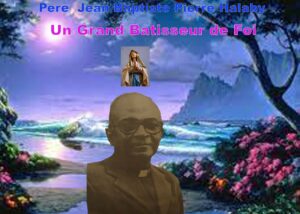
The 340th anniversary of the Notre-Dame du Rosaire Parish of Croix-des-Bouquets is coming to an end at the end of December 2023. It is still a very difficult year for Haiti, particularly for Croix-des-Bouquets. This parish has a great history, it is one of the oldest in the Republic of Haiti and one of the largest parishes in the Archdiocese of Port-au-Prince. It was founded during the colony. The Notre-Dame du Rosaire parish church of Croix-des-Bouquets is and will always remain a great heritage for the Crucian community of Haiti and the diaspora.
To close the 340th anniversary of the Notre-Dame du Rosaire Parish, I saw fit to write this text on the late Father Jean Baptiste Pierre Halaby, the 2nd priest of the Catholic Church of Haiti originally from the Croix-des -Bouquets. The Notre-Dame du Rosaire parish in Croix-Des-Bouquets has already given 17 priests. Father Halaby, this great builder of faith, doubled as a unifier, is a great light for the Catholic Church of Haiti, for the priests from Croix-des-Bouquets and for the large Crucian community for his humility, for his great ecclesial solidarity, his great closeness to the poor as a priest who had taken vows of obedience, chastity and poverty and his great qualities of human relations.
Father Jean Baptiste Pierre Halaby was born on February 17, 1923 in Croix-des-Bouquets and came from a family of 4 children on the maternal side. He was the son of Mr. Jean Baptiste Pierre Halaby and the 4th child of Mrs. Irma Mirville. Young Halaby from his childhood was very spiritual and he was also a former altar boy of the Notre Dame du Rosaire Parish of Croix-Des-Bouquets The Mirville family is among the ancient families of Croix-des-Bouquets. Father Halaby’s father was from Syria and his mother was one of the beautiful women of the Crucian community of her time. The young Jean Baptiste Pierre Halaby had completed all his secondary education in Port-au-Prince at the Petit Séminaire Collège Saint Martial, considered one of the most prestigious schools in Haiti at the time.
It was at the Collège Saint Martial Minor Seminary that young Halaby heard the voice of the Lord asking him to come and work in his vineyard. He thus agreed to give his entire existence to God in priestly life. I had always been told that it was young people from the elite of Haiti who had the blessing of the Breton priests in Haiti who had the chance to study at the Petit Séminaire Collège Saint Martial at the time of young Halaby. The latter, after his secondary studies, was accepted at the Apostolic School to continue his journey with God in order to receive solid training and better discern his call or vocation. The life of someone called into the Lord’s harvest is always a special moment, a time of deep reflection, deep discernment and intimate relationship with God. The Lord and Manman Wozè accompanied young Halaby in his spiritual and intellectual journey since his primary and secondary studies, at the Apostolic School and during his 28 years of priestly life.
What was life like for Haitian students at the Apostolic School of Haiti during the time of young Halaby? At that time we did not yet have the Catholic Major Seminary in Haiti. The Apostolic School of Haiti was located in the courtyard of the Archbishopric of Port-au-Prince. Candidates for the priesthood were under close supervision and overcame many obstacles before arriving at their ordination as priests within the Catholic Church. You can easily understand the problems and challenges of the candidates for the ministerial priesthood who had studied at the Apostolic School of Port-au-Prince. All priestly ordinations of Haitian priests of that time and even before were done in the archdiocese of Port-au-Prince and our bishops were foreigners or French.
To this end, it is good to emphasize that the encyclical Princeps Pastorum of Pope John XXIII (November 30, 1959) has always reminded us of the importance of local clergy in mission countries. This necessarily requires the establishment of a local hierarchy composed of priests and bishops of that country. The encyclical Maximum Illud or the apostolic letter of Pope Benedict people from which he comes, which gives him unparalleled ease in introducing the Christian faith into the minds of his people. We must not forget the the declaration of Pope Pius XI
(February 6, 1922-February 10, 1939) who let us know that the only way to really solve the problem of the need for priests in mission countries was to train them on site..
We had to wait until October 28, 1966, after more than a century since the signing of the Concordat between the Haitian State and the Vatican, to see the sons of Haiti assume the spiritual direction of the dioceses of Haiti. No one can forget the famous song of the great samba Joseph Augustin (Papy Djo) for the episcopal consecration of October 28, 1966 of the first Haitian bishops: “Evèk Kreyòl nan yon legliz an Kreyòl, pou yon Pèp an Kreyòl…”. Papy Djo was the brother of Monsignor Rémy Jérôme Augustin of the Company of Mary (in Latin: Societas Mariæ Montfortana), the Montfortains. He was the first Haitian bishop and first Haitian bishop of the diocese of Port-de-Paix (September 30, 1910 – March 29, 1983)
Furthermore, young Halaby was known as a great sportsman. He played football very well and thanks to his talents he could even be among the players of the Haitian national team. His great passion for football sometimes led him to travel to support the national team in its tournaments abroad.
You can imagine the joy of Father Halaby’s parents and the Crucian community of the Catholic faith in attending his priestly ordination on July 11, 1949. He was ordained at the cathedral of Port-au-Prince by Monsignor Joseph Le Gouaze, archbishop of Port-au-Prince. au-Prince. He was vicar or assisted Father Farnese Louis Charles from September 1949 to May 1950. He successively exercised his ministry at the Cathedral of Port-au Prince, director of the Apostolic School, general chaplain of the female student youth, administrator of the parish of Christ the King, Pastor of the Parish of Ste Rose of Lima where he transformed the choir of the church by introducing the altar facing the people to the great amazement and admiration of everyone, and finally Pastor of St Joseph Parish in 1967 where he spent the last 40 years of his life.
According to my research, the late Halaby was a great preacher and he always took care to prepare his homilies and liturgical celebrations well. He introduced the mass in Creole in the parish of Saint Joseph as well as the use of the drum, during a large and beautiful Eucharistic celebration where the Reverend Father Joseph Augustin (Papy Djo) of the Tamboula troupe, known one of the great Haitian Sambas and who played a great role in the success of this Eucharistic celebration. Father Halaby, this great builder of faith, strengthened devotion to St. Joseph when he made the decision to celebrate a mass every Wednesday at 11:00 a.m. at the Saint Joseph parish for pilgrims from all social strata of society. Haitians came from everywhere (including parishioners of the Notre Dame du Rosaire parish of Croix-Des-Bouquets) to pray at this religious ceremony or to implore the fervor of Saint Joseph for one or more difficult causes.
The expansion of the church of St Joseph Parish is among Father Halaby’s great achievements. According to priest-lawyer Jomanas Eustache, Father Jean Baptiste Pierre Halaby was the first to introduce the electronic organ into St Joseph’s Church on the occasion of the centenary of the parish in 1973 and the first Catholic priest to organize a night mass on December 31 in the archdiocese of Port-au-Prince at the parish of Saint Joseph. He restored the presbytery of the St Joseph parish. He founded the Medico Social Center run by the Daughters of Wisdom. We cannot forget that it is under his leadership that we will succeed in twinning the parish of St Joseph in the archdiocese of Port-au-Prince and that of Ste Claire de Sommerville in Montreal.
According to the information collected, Father Halaby was elevated to the rank of canon (Chanoine). He was among the important collaborators of Archbishop Le Gouaze in the conduct of religious affairs of the Archdiocese of Port-au-Prince. He was a very cultured priest, a good writer. He had written several articles for the Journal Catholique la Phalange. According to Father Danis Ridoré, former pastor of the church of Jacmel which became the cathedral of Jacmel and former vicar of the St Joseph parish in Port-au-Prince for 2 years, Father Halaby was very good or always correct with his parishioners. He always treated his colleagues well. He had a great closeness with the poor of Haiti. He loved the poor people who begged at the church gate and helped them as best he could. Priest-lawyer Jomanas told us this anecdote about Father Halaby: “The old Port-au-Princiens of his generation and the previous one undoubtedly still remember the barges, a sort of van intended to transport barefoot people. , the filthy or the ragged intercepted throughout the city. It was during the week before the celebration of St Joseph’s Day, the municipal administration of Port-au-Prince had the habit, in accordance with the diocesan statutes derived from the Concordat, of having the main and side facades of the parish church as well as cleaning the entire perimeter of the building. One fine morning, the men of a barge suddenly disembark and take on board all the poor people who were within their reach. Informed of this “raid”, Father Halaby immediately arrived on the spot and took his place in the van among the unfortunate people. Asked to come down, he categorically refused, arguing that he would only do so on condition of getting everyone else down before him. Faced with such determination, the commander satisfied the prelate’s request by ordering his men to evacuate the vehicle. And to think that we were under a dictatorship! “.
In addition, Father Halaby loved to laugh, he had very good friends in the Haitian clergy. Priest-lawyer Jomanas Eustache, former child of Heart of Father Halaby at St Joseph parish, sent me a list of bishops and priests who were going to visit Father Halaby at St Joseph parish: Mgr Rémy Augustin, first bishop Haitian and former Bishop of Port-de-Paix; Mgr François Wolf Ligondé, first Haitian Archbishop of Port-au-Prince; Mgr Jean-Baptiste Décoste, former Auxiliary Bishop of Port-au-Prince, promoted to Founding Bishop of the Diocese of Hinche in April 1972; Mgr Jean-Jacques Claudius Angénor, first Haitian Bishop of the diocese of Les Cayes; Mgr Alexandre, former regent of the Archdiocese of Port-au-Prince and priest of Ste Bernadette in Martissant; Mgr Albert Dorélien, Vicar General and Parish Priest of Carrefour; Mgr Jean Noël, priest of the cathedral of Port-au-Prince; Mgr Emmanuel Kébreau, former honorary prelate of His Holiness and parish priest of Sainte Anne or the Delva Fathers, chaplain of the hospital of the State University of Haiti, better known at the time under the name of general hospital; Father Eustache St Hubert, former priest of Jacmel; Canon Roger Cassagnol, parish priest of Petit Goâve; Fathers Marion, priest of Croix-des-Bouquets, Bouillaguet, priest of Bodari, Joseph Atis, priest of St Martin (St Yves) in Delmas, Dominique Henry, former priest of Abricots, Burnet François, priest of Bodin, Pierre Laforêt of St Martial, P. Marc Hilaire de Port Margot, P. Eugène Marie Thalès, who was still a monk (probably the first Haitian monk, to our knowledge, in any case), he often went to visit Father Jean Noël, at the Cathedral , Father Kébreau at Sainte Anne parish, Father Albert Dorélien at Carrefour, Father Saint Hubert and Father Delva.
Monsignor Madelon Eustache, former Pastor of the Notre-Dame du Rosaire parish of Croix-des-Bouquets, Pastor of the Notre-Dame du Perpétuel Secours parish in Laserre and one of the great sambas of the Catholic Church of Haiti, remembers Father Halaby as an architect of peace, unity and communion among the Haitian clergy. His presbytery was a rallying place, a center of attraction for his brother priests . Father Halaby was an exemplary priest, very sensitive, very fraternal, a good joker and sometimes laughed until tears when he was with his favorite friends. He was very interested in Haitian politics, he regularly listened to the news from Haiti. With his friends he never hid his opinion and his position on current issues in Haiti.
I was fortunate to have on the phone Father William Smarth, one of the luminaries of the Haitian clergy, doctor in Canon Law, who has already had more than 60 years of priestly life and author of a work entitled ”History of the church of Haiti from 1492 to 2003”. He told me that Father Halaby was a very cordial priest, a good nationalist, he was everyone’s friend and had done everything to be a good Haitian priest of his time. Father Smarth also mentioned the problems and challenges of candidates for the priesthood in Haiti during the time of Jean Baptiste Pierre Halaby. I urge you to read Father Smarth’s work (History of the Catholic Church of Haiti from 1492 to 2003) if you want to have a good idea of the Church of Haiti.
Our life on earth is always a short pilgrimage. Father Jean Baptiste Pierre Halaby died on June 7, 1977 in New York at the age of 54 after an illness courageously endured. His funeral was held at the St Joseph parish in Port-au-Prince and his remains buried in the crypt of the chapel. For Many like Father-Lawyer Jomanas and Father Danis Ridore The late Father Halaby left too young and too quickly. His departure caused great mourning throughout Port-Au-Prince and in Croix-Des-Bouquets We continue to work to have a talk show in honor of the late Father Halaby, this son of Croix-des-Bouquets, this architect of peace and unity within the Haitian clergy. I warmly thank Ms. Fulvie Bellevue, this crucian who lives in Ottawa who encouraged me to write a text on the late Father Halaby, Mr. Jean Philippe Vixamar, economist by training and former president of The national Credit Bank in Haiti who sent me the first information on Father Halaby; Priest-lawyer Jomanas Eustace, Mgr. Saint Hubert Eustache, Father Danis Ridoré, Father William Smarth PhD, Father Godefroy Midy SJ, Monsignor Madelon Eustache , Father Jean Gaetan Louis Boursiquot, and His Excellency The Most Reverend Jean Baptiste Décoste who made their valuable contribution to the creation of this text on the late Father Jean Baptiste Pierre Halaby. May his soul rest in peace!
Brother Buteau (Brother Tob)

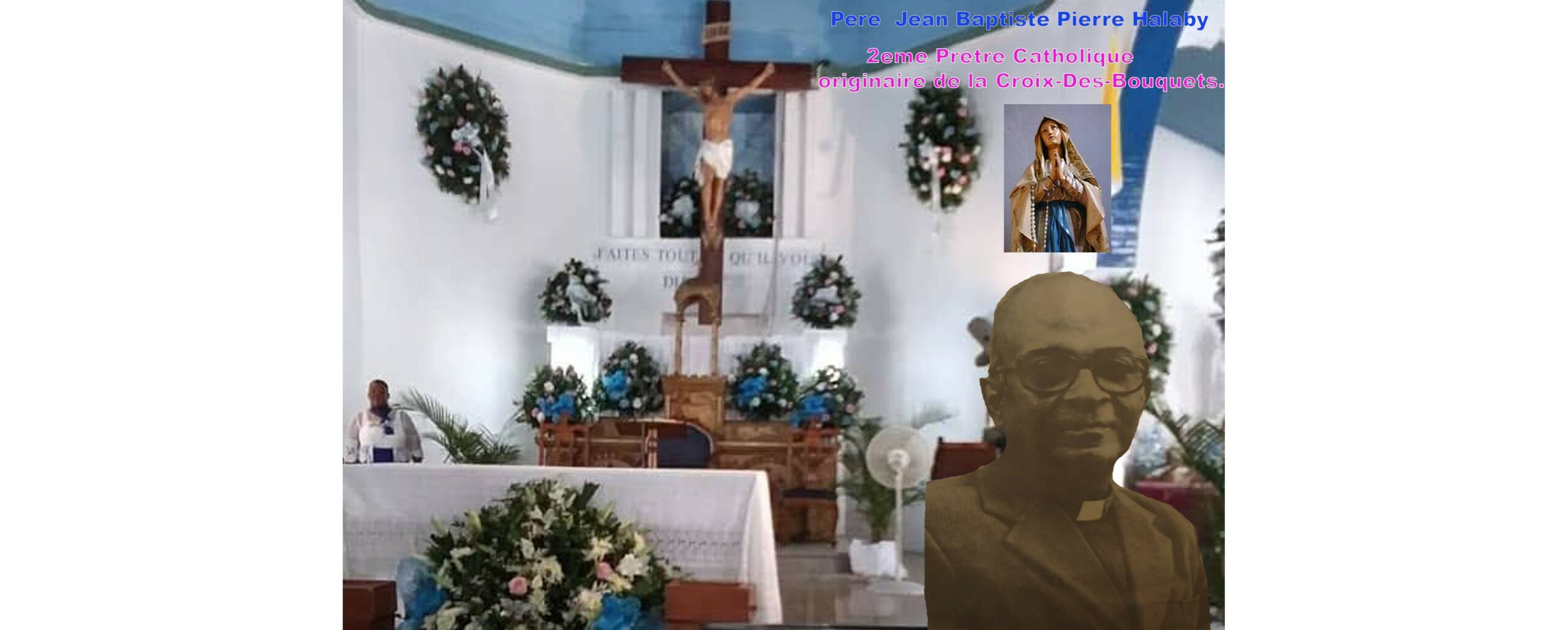
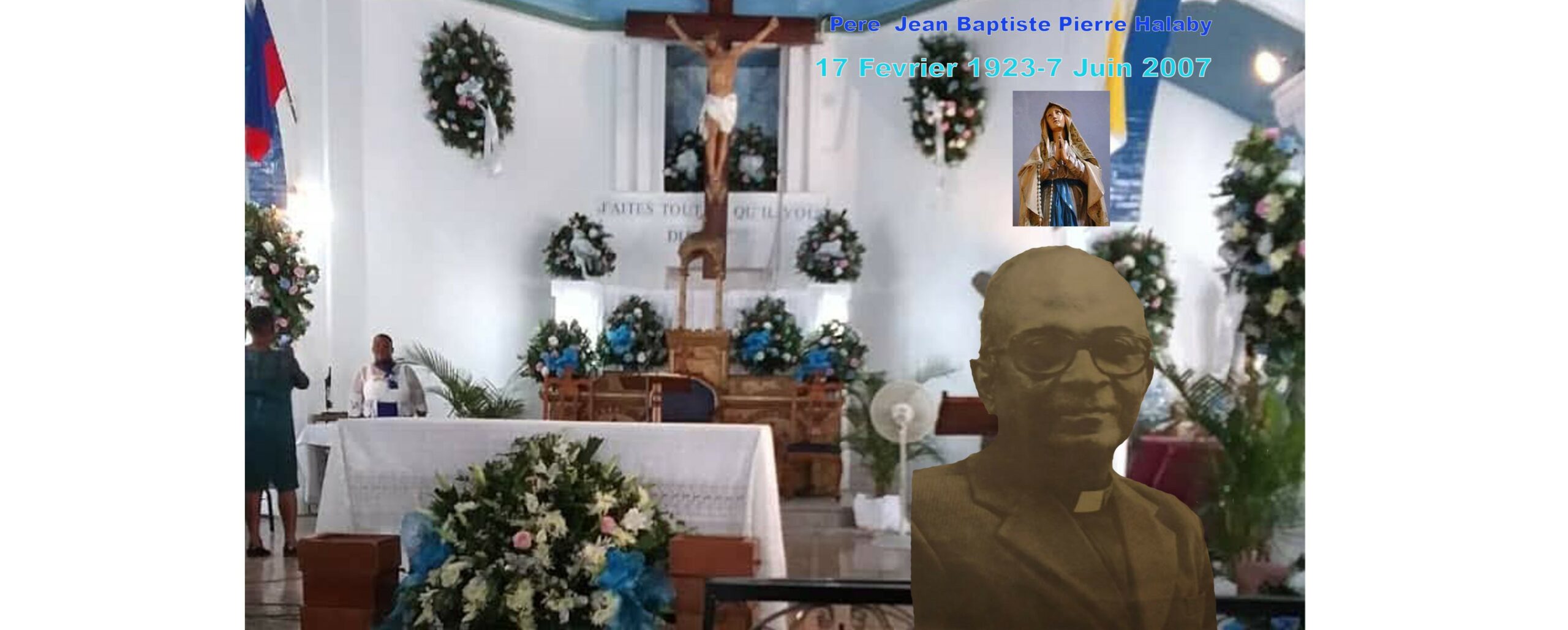
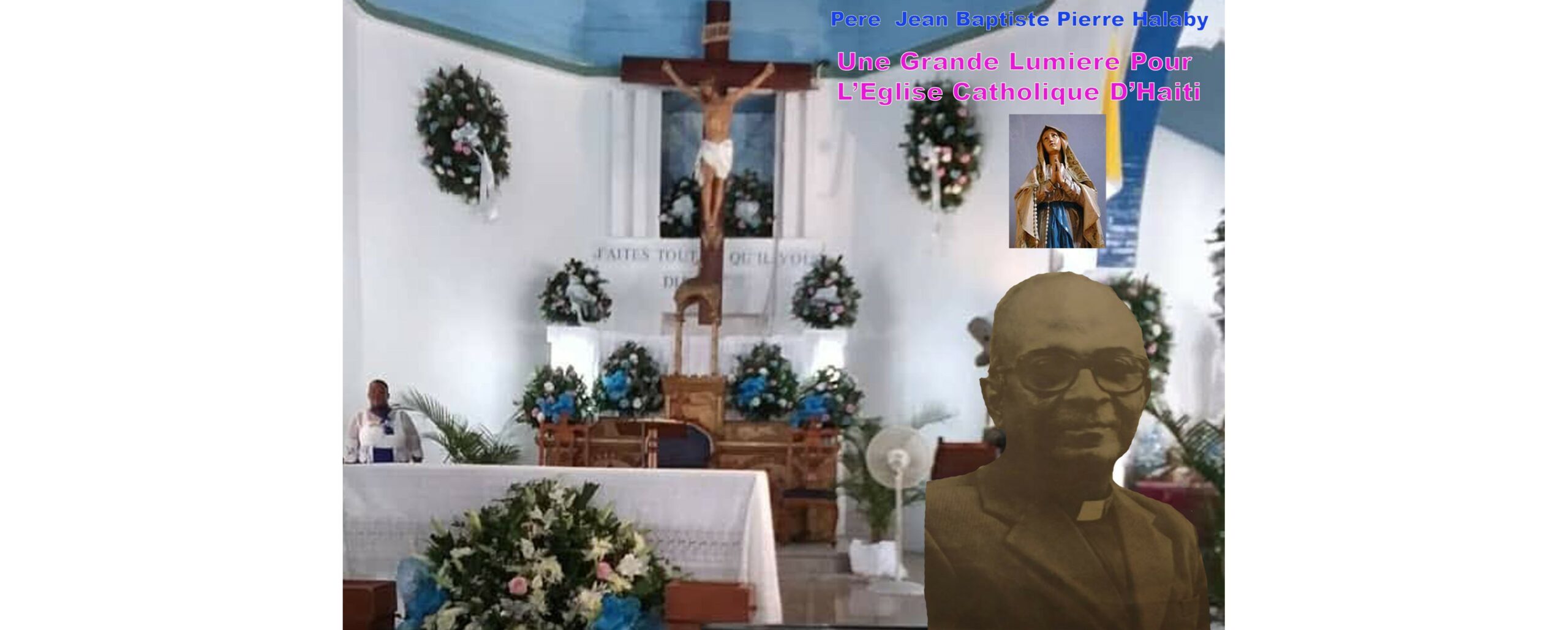

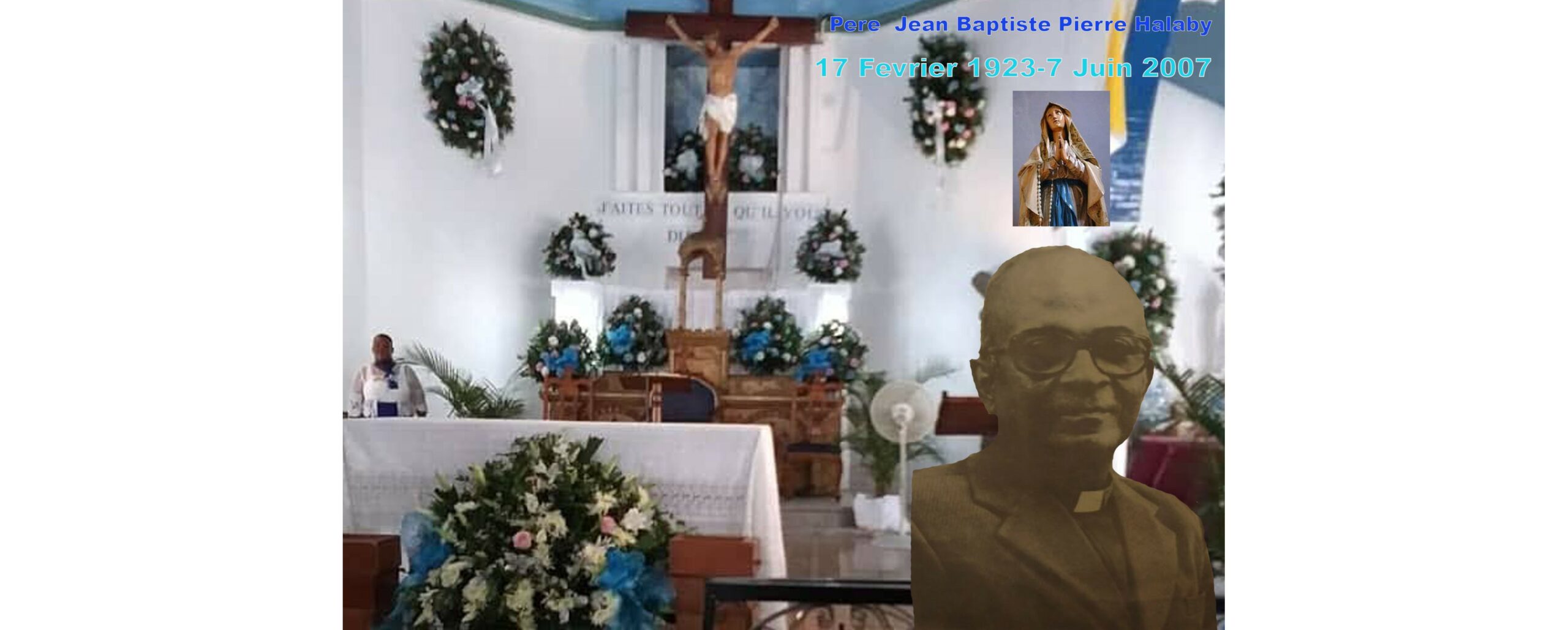

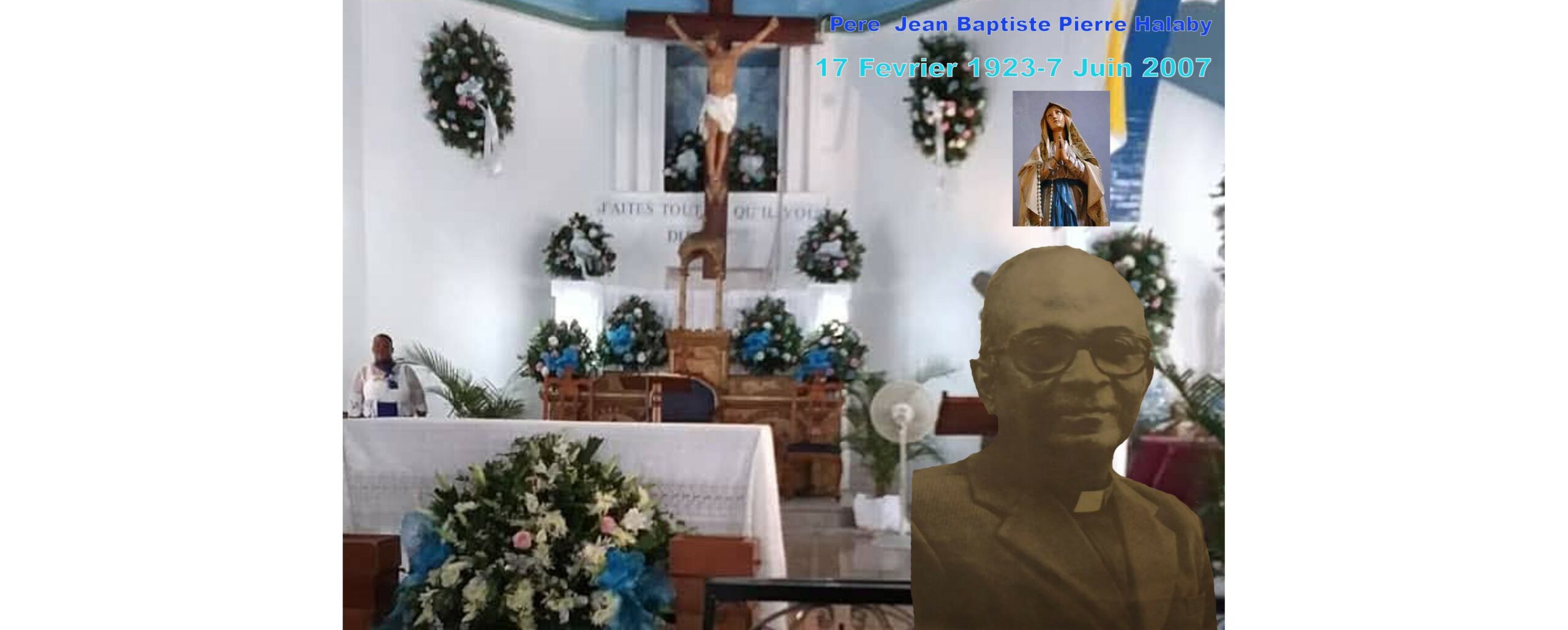

Recent Comments